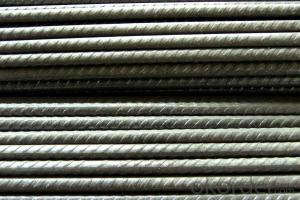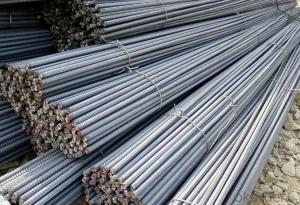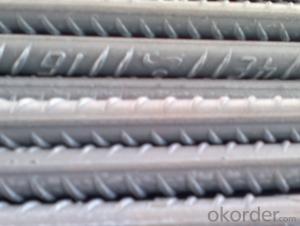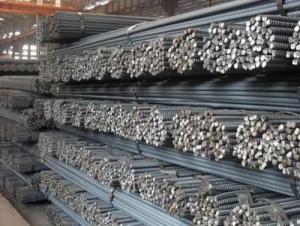Deformed steel bar
- Loading Port:
- China Main Port
- Payment Terms:
- TT OR LC
- Min Order Qty:
- -
- Supply Capability:
- -
OKorder Service Pledge
OKorder Financial Service
You Might Also Like
Product Description:
Specifications of Deformed Steel Bar:
Standard | GB | HRB335, HRB400, HRB500 | |
UK | G460B, B500A, B500B,B500C | | |
USA | GR40, GR60 | | |
Diameter | 6mm,8mm,10mm,12mm,14mm,16mm,18mm,20mm, 22mm,25mm,28mm,32mm,36mm,40mm,50mm | | |
| | |||
Length | 6M, 9M,12M or as required | | |
Place of origin | Hebei, China mainland | | |
Application | building,construction,road,bridge etc | | |
Brand name | DRAGON | | |
Theoretical weight and section area of each diameter as below for your information:
Diameter(mm) | Section area (mm²) | Mass(kg/m) |
6 | 28.27 | 0.222 |
8 | 50.27 | 0.395 |
10 | 78.54 | 0.617 |
12 | 113.1 | 0.888 |
14 | 153.9 | 1.21 |
16 | 201.1 | 1.58 |
18 | 254.5 | 2.00 |
20 | 314.2 | 2.47 |
22 | 380.1 | 2.98 |
25 | 490.9 | 3.85 |
28 | 615.8 | 4.83 |
32 | 804.2 | 6.31 |
36 | 1018 | 7.99 |
40 | 1257 | 9.87 |
50 | 1964 | 15.42 |
Usage and Applications of Deformed Steel Bar:
Deformed bar is widely used in buildings, bridges, roads and other engineering construction. Big to highways, railways, bridges, culverts, tunnels, public facilities such as flood control, dam, small to housing construction, beam, column, wall and the foundation of the plate, deformed bar is an integral structure material. With the development of world economy and the vigorous development of infrastructure construction, real estate, the demand for deformed bar will be larger and larger..
Packaging & Delivery of Deformed Steel Bar:
Packaging Detail: products are packed in bundle and then shipped by container or bulk vessel, deformed bar is usually naked strapping delivery, when storing, please pay attention to moisture proof. The performance of rust will produce adverse effect.
Each bundle weight: 2-3MT, or as required
Payment term: TT or L/C
Delivery Detail: within 45 days after received advanced payment or LC.
Label: to be specified by customer, generally, each bundle has 1-2 labels
Trade terms: FOB, CFR, CIF
Deformed Steel Bar in Coil

Produce Line of Deformed Steel Bar
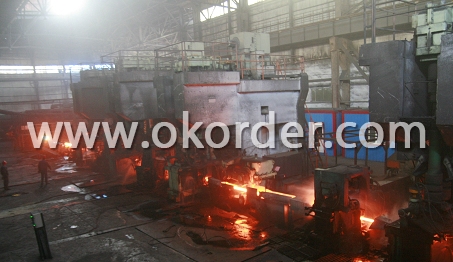
Note:
1. Our products are produced according to national standard (GB), if not, supply according to national standards (GB) or agreement as customer required.
2. Other Grade and Standard Deformed Steel Bar we can supply:
Grade: GR40/GR60, G460B/B500A/B500B/B500C,BST500S
Standard: ASTM, BS, DIN
The Minimum Order Quantity of these products is high, and need to be confirmed.
3. We can not only supply Deformed Steel Bar; if you need anything about building materials, please contact us for further information.
4. Please send us your detail specifications when inquire. We will reply to you as soon as possible. We sincerely hope we can establish a long stable business relationship.
- Q:How do steel rebars affect the weight of a concrete structure?
- Steel rebars increase the weight of a concrete structure as they are added to provide reinforcement. The weight of the rebars themselves adds to the overall weight, but their main impact is in increasing the load-bearing capacity and strength of the concrete, allowing it to withstand greater forces and improve the structural integrity.
- Q:Can steel rebars be spliced or joined together on-site?
- Yes, steel rebars can be spliced or joined together on-site. This is typically done using various methods such as welding, mechanical couplers, or lap splicing techniques, depending on the specific requirements and structural design.
- Q:What is the role of steel rebars in maintaining structural integrity?
- Steel rebars play a crucial role in maintaining structural integrity by reinforcing and strengthening concrete structures. They provide tensile strength to resist cracking, bending, and shearing forces, enhancing the overall stability and durability of buildings, bridges, and other infrastructure.
- Q:What is the role of steel rebars in load-bearing structures?
- The role of steel rebars in load-bearing structures is crucial and multifaceted. Steel rebars, short for reinforcing bars, are used to provide reinforcement and strength to concrete structures. They are typically made of carbon steel and are strategically placed within the concrete to counteract its low tensile strength and enhance its ability to withstand tension and compression forces. In load-bearing structures, such as buildings, bridges, dams, and other infrastructure projects, steel rebars play several key roles: 1. Reinforcement: Concrete on its own has excellent compressive strength but lacks tensile strength. Steel rebars are embedded within the concrete to absorb tensile forces and prevent cracks from forming or propagating. By reinforcing the concrete, they help distribute and manage the loads more effectively, ensuring the structural integrity and durability of the building. 2. Load distribution: Steel rebars assist in distributing the weight and load-bearing capacity of the structure more evenly. They help to transfer the applied loads, such as the weight of the structure itself, live loads, or environmental forces, to the foundation or other supporting components. This redistribution of forces prevents localized damage and ensures the structure can handle various external and internal loads. 3. Flexibility and ductility: Steel rebars provide flexibility and ductility to the concrete. This means that even if the structure is subjected to heavy loads, vibrations, or external forces, the rebars can absorb and distribute the stress across the structure, minimizing the risk of failure. Steel rebars are particularly effective in areas prone to earthquakes, where they help to absorb and dissipate seismic energy. 4. Longevity and durability: By reinforcing the concrete, steel rebars significantly increase the longevity and durability of load-bearing structures. They help to prevent cracking, shifting, and other structural issues that may arise due to aging, environmental factors, or excessive loading. This extended lifespan ensures the safety and stability of the structure over time. Overall, steel rebars are crucial components in load-bearing structures as they provide reinforcement, enhance load distribution, increase flexibility, and improve the longevity and durability of the structure. Their inclusion allows for the construction of safer, stronger, and more resilient buildings and infrastructure projects.
- Q:Can steel rebars be used in road construction projects?
- Yes, steel rebars can be used in road construction projects. Steel rebars are commonly used as reinforcement in concrete structures, including roads. They help to increase the overall strength and durability of the road by reinforcing the concrete. The rebars are typically placed within the concrete pavement to provide tensile strength and prevent cracking or breaking under heavy loads. Additionally, steel rebars are corrosion-resistant, which is essential for road construction projects where exposure to moisture and harsh weather conditions is common. Overall, using steel rebars in road construction projects enhances the structural integrity and longevity of the road.
- Q:Are steel rebars suitable for reinforcement in historical monuments?
- Yes, steel rebars are suitable for reinforcement in historical monuments. They provide excellent strength and durability, ensuring the structural stability of the monuments over time. Additionally, steel rebars can be easily integrated into existing structures without causing significant damage or alteration to the original design.
- Q:How do steel rebars affect the overall maintenance requirements of concrete structures?
- Steel rebars, being strong and durable, enhance the structural integrity of concrete structures. By providing reinforcement, rebars help in distributing the load and increasing the resistance to cracking and tension. This leads to reduced maintenance requirements for concrete structures as they become more resistant to wear and tear, environmental factors, and potential structural failures.
- Q:How do steel rebars prevent concrete structures from cracking under load?
- Steel rebars, or reinforcing bars, are essential components in concrete structures as they play a crucial role in preventing cracking under load. There are several ways in which rebars contribute to the structural integrity and durability of concrete: 1. Reinforcement: Steel rebars provide additional strength to the concrete by acting as tension members. Concrete is strong in compression but relatively weak in tension. When a load is applied to a concrete structure, rebars absorb the tensile forces and distribute them throughout the structure, reducing the risk of cracking. 2. Load transfer: By embedding rebars within the concrete, they help in transferring the loads from one section to another. This load transfer mechanism ensures that the stresses are distributed evenly, preventing concentrated stress points that could lead to cracking. 3. Bonding: The surface texture and ridges on the rebar enhance its bond with the concrete. This bond is critical as it allows the rebar to effectively transfer stress between the concrete and the steel. The interlocking action between the two materials ensures that the concrete and the rebars work together, increasing the overall strength and load-bearing capacity of the structure. 4. Expansion and contraction control: Concrete structures are subjected to temperature variations, which can cause them to expand or contract. Steel rebars help control these movements by providing stability and limiting the extent of cracking. The rebars absorb and accommodate the expansion and contraction, reducing the risk of extensive cracking and maintaining the structural integrity. 5. Flexibility: Steel rebars possess a high degree of flexibility, which allows them to absorb dynamic loads and stresses. This flexibility ensures that the rebars can withstand external forces without fracturing or causing damage to the concrete. By absorbing and distributing these loads, rebars prevent cracks from forming and propagate through the structure. In summary, steel rebars prevent concrete structures from cracking under load by reinforcing the concrete, transferring loads, enhancing bonding between concrete and steel, controlling expansion and contraction, and providing flexibility to absorb dynamic forces. Their presence in concrete structures significantly improves their strength, durability, and resistance to cracking under various loading conditions.
- Q:What are the properties of steel rebars?
- Steel rebars, also known as steel reinforcing bars, possess several important properties. Firstly, they have high tensile strength, making them capable of withstanding heavy loads and stresses without breaking or bending easily. Secondly, they have excellent durability and resistance to corrosion, which ensures their long-term structural integrity. Moreover, steel rebars exhibit good thermal conductivity, allowing them to dissipate heat efficiently in high-temperature environments. Additionally, they are malleable and can be easily bent or shaped to fit different construction needs. Lastly, steel rebars have excellent bond strength with concrete, enabling the efficient transfer of loads between the two materials in reinforced concrete structures.
- Q:Are there any limitations or restrictions on using steel rebars in construction?
- Yes, there are certain limitations and restrictions on using steel rebars in construction. Here are some of them: 1. Corrosion: Steel rebars are prone to corrosion when exposed to moisture and certain chemical environments. This can weaken the rebars over time and compromise the structural integrity of the construction. To mitigate this limitation, protective coatings or stainless steel rebars can be used. 2. Fire Resistance: Steel rebars can lose their strength and become malleable when exposed to high temperatures during a fire. This can lead to structural failure. Fireproofing measures such as fire-resistant coatings or using concrete encasement can help enhance the fire resistance of steel rebars. 3. Weight: Steel rebars can be quite heavy, especially for large-scale construction projects. This can pose challenges during transportation, handling, and installation. It may require additional labor or equipment to handle the weight, which can increase project costs. 4. Thermal Expansion: Steel has a relatively high coefficient of thermal expansion, meaning it expands and contracts significantly with temperature changes. This can lead to thermal stresses and potential cracking in the concrete surrounding the rebars. Proper design techniques and the use of expansion joints can help accommodate thermal expansion and mitigate this limitation. 5. Electromagnetic Interference: Steel rebars can interfere with electromagnetic signals, such as those used in communication systems or sensitive electronic equipment. This limitation needs to be considered when constructing buildings with specific requirements, such as hospitals or laboratories. 6. Cost: The cost of steel rebars can fluctuate depending on market conditions, availability, and quality. This can impact the overall budget of construction projects, especially when large quantities of rebars are required. It is important to note that while steel rebars have limitations, they have been widely used in construction due to their strength, durability, and availability. Proper design, construction techniques, and maintenance can help overcome these limitations and ensure the safe and efficient use of steel rebars in buildings and infrastructure.
1. Manufacturer Overview |
|
|---|---|
| Location | |
| Year Established | |
| Annual Output Value | |
| Main Markets | |
| Company Certifications | |
2. Manufacturer Certificates |
|
|---|---|
| a) Certification Name | |
| Range | |
| Reference | |
| Validity Period | |
3. Manufacturer Capability |
|
|---|---|
| a)Trade Capacity | |
| Nearest Port | |
| Export Percentage | |
| No.of Employees in Trade Department | |
| Language Spoken: | |
| b)Factory Information | |
| Factory Size: | |
| No. of Production Lines | |
| Contract Manufacturing | |
| Product Price Range | |
Send your message to us
Deformed steel bar
- Loading Port:
- China Main Port
- Payment Terms:
- TT OR LC
- Min Order Qty:
- -
- Supply Capability:
- -
OKorder Service Pledge
OKorder Financial Service
Similar products
New products
Hot products
Hot Searches
Related keywords


